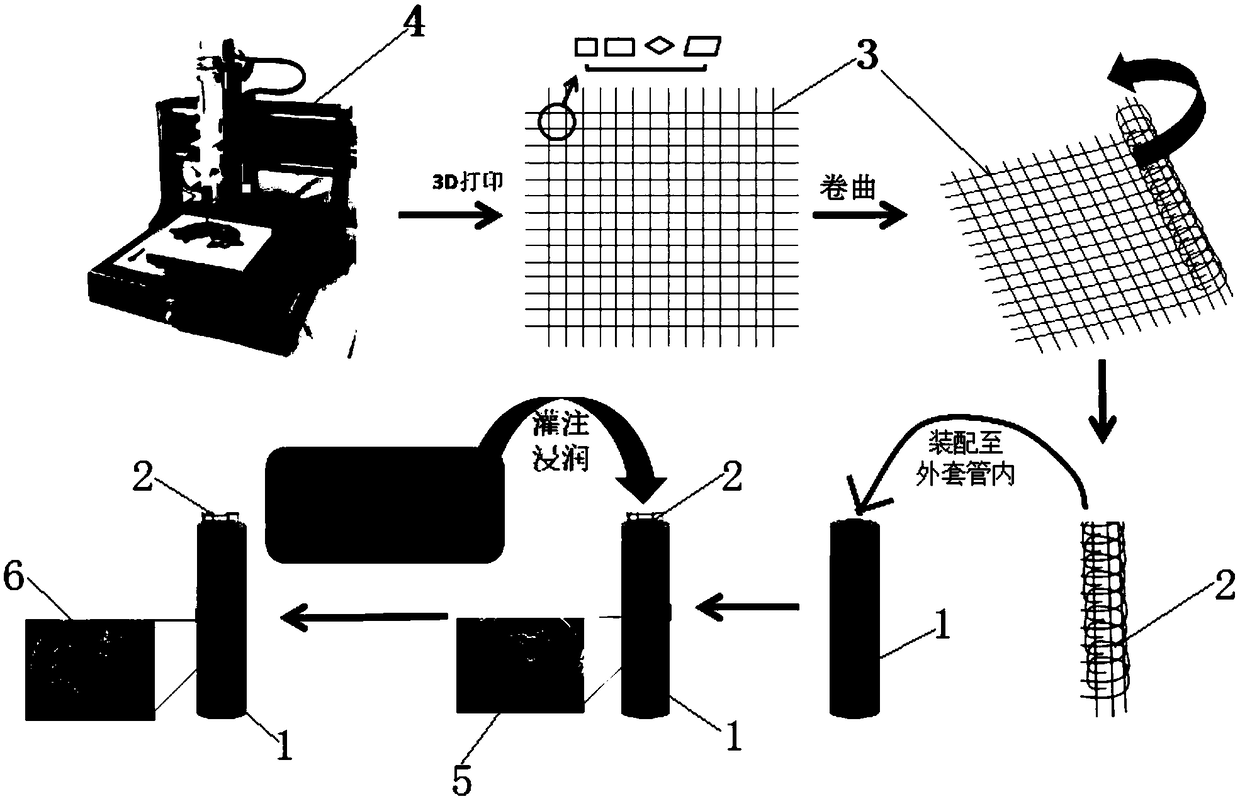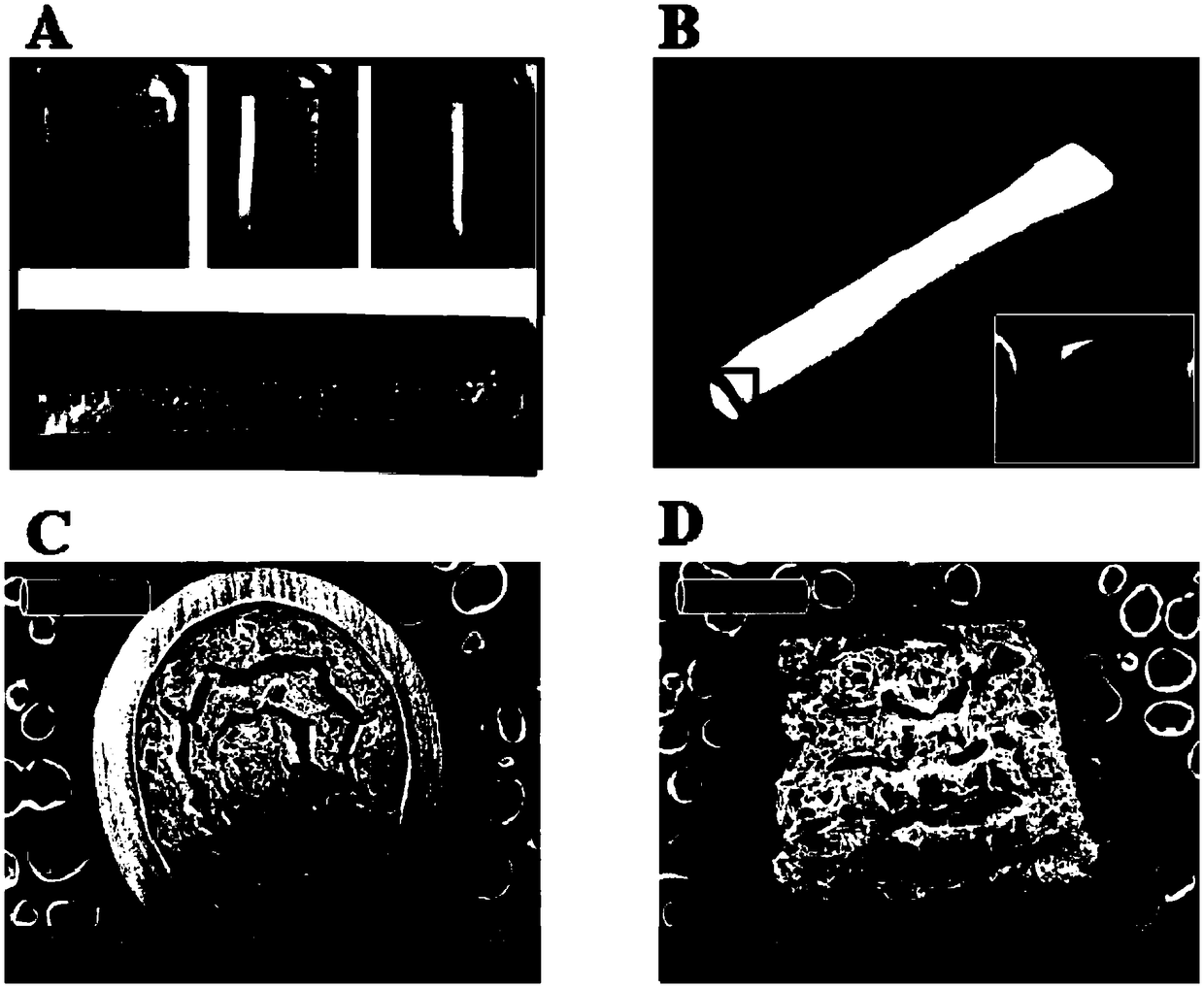Peripheral nerve stent based on 3D (three-dimensional) printing and preparation method thereof
A peripheral nerve and 3D printing technology, applied in medical science, prosthesis, additive processing, etc., can solve problems such as difficult to achieve cell or active protein loading, large differences in mechanical properties, difficult to meet stability, etc., to achieve structural and The preparation method is simple, the molding strength requirement is reduced, and the effect is easy to realize
- Summary
- Abstract
- Description
- Claims
- Application Information
AI Technical Summary
Problems solved by technology
Method used
Image
Examples
Embodiment 1
[0040] Such as figure 1 As shown, an embodiment of the peripheral nerve stent based on 3D printing of the present invention includes an outer sleeve 1 and a filler disposed in the outer sleeve 1, the filler is a three-dimensional skeleton 2 formed by crimping a gauze 3, and the gauze 3 is made of bio-ink, the outer sleeve 1 is made of electrospinning, the electrospinning is made of PLGA, and the gauze 3 is made of 3D printing.
[0041]Wherein, the bio-ink is a hydrogel prepared by modifying PEG with double bond end groups of acrylic acid; the three-dimensional skeleton is perfused or infiltrated with a solution that can promote axon growth, which contains β-NGF.
[0042] The preparation method of above-mentioned peripheral nerve stent, comprises the steps:
[0043] (1) Provide an outer sleeve made of electrospun material;
[0044] (2) Two-dimensional gauze was prepared by using an ink with dual sensitivity to temperature and ultraviolet light (bio-ink) and a 3D printing meth...
Embodiment 2
[0049] An embodiment of the peripheral nerve stent based on 3D printing of the present invention includes an outer sleeve 1 and a filler disposed in the outer sleeve 1. The filler is a three-dimensional skeleton 2 formed by crimping a gauze 3, and the gauze 3 adopts biological It is made of ink, the outer sleeve 1 is made of electrospinning, the electrospinning is made of PLLA and PCL, and the gauze is made of 3D printing method.
[0050] Among them, the bio-ink is hyaluronic acid modified by acrylic acid or norbornene; the three-dimensional framework is perfused or infiltrated with a hydrogel obtained by decellularizing and pulverizing peripheral nerves from pigs and digesting them with pepsin.
[0051] The preparation method of above-mentioned peripheral nerve stent, comprises the steps:
[0052] (1) Provide an outer sleeve made of electrospun material;
[0053] (2) Two-dimensional gauze was prepared by using ink with dual sensitivity to temperature and ultraviolet light (b...
Embodiment 3
[0058] An embodiment of the peripheral nerve stent based on 3D printing of the present invention includes an outer sleeve 1 and a filler disposed in the outer sleeve 1, the filler is a three-dimensional skeleton 2 formed by crimping gauze, and the gauze 3 uses bio-ink The outer casing 1 is made by electrospinning, the electrospinning is made by PTMC, and the gauze is made by 3D printing.
[0059] Among them, the bio-ink is tissue decellularized hydrogel; the tissue is pig-derived peripheral nerve, spinal cord, small intestinal submucosa, umbilical cord, placenta or amniotic membrane; the three-dimensional skeleton is perfused or infiltrated with β-NGF containing β-NGF that can promote axon growth. solution.
[0060] The preparation method of above-mentioned peripheral nerve stent, comprises the steps:
[0061] (1) Provide an outer sleeve made of electrospun material;
[0062] (2) Two-dimensional gauze was prepared by using an ink with dual sensitivity to temperature and ultr...
PUM
 Login to View More
Login to View More Abstract
Description
Claims
Application Information
 Login to View More
Login to View More - R&D
- Intellectual Property
- Life Sciences
- Materials
- Tech Scout
- Unparalleled Data Quality
- Higher Quality Content
- 60% Fewer Hallucinations
Browse by: Latest US Patents, China's latest patents, Technical Efficacy Thesaurus, Application Domain, Technology Topic, Popular Technical Reports.
© 2025 PatSnap. All rights reserved.Legal|Privacy policy|Modern Slavery Act Transparency Statement|Sitemap|About US| Contact US: help@patsnap.com


